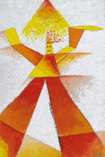 |
 |
Robot Dynamism |
|
 |
The desire for a "completely
new and original... mechanical world" led Sassu to make his drawing of 1927 dedicated
to machine-people: Robot Dynamism and L’uomo meccanico. And, along with the typical
expressions dedicated to the dynamism of modern means of transportation, as seen in Il
treno, Auto in corsa, Airplane+Sun, he elaborated strongly synthesized
representations, both from the formal and chromatic points of view, of the industrial
landscape. Examples are the drawing Il porto, contemporary with the study for Porta
Venezia, and Metal Foundry, Altiforni,
and Miners on 1927, all anticipating an antinaturalism which is more pronounced in
the later The Furnaces and The Forge. In
the small pen-and-ink The Builders, of 1927, preparatory for the tempera on paper with the same title of
1929, and in charcoal and pastel portraits like Teppa and L.P., a
Futurist-Boccionian structure survives, while in some temperas of 1928-29 like the series Creation a consonance of style can be detected with the research being done in
those same years by Giandante X. |
 |
 |
Creation |
|
 |
But by now we are at the end of his
experience of Futurism: between 1928 and 1929 he participated for the last time in a
manifestation by the group, that is, the "Mostra d’Arte Futurista, Novecentista,
Strapaesana" in Mantua, where he exhibited Guerra and Costruzione. In
this phase emerges the contrast between his search for a soft, delicately handled painting
style, aiming at a solid grasp of the forms, and the use of flat colors still being
practiced by the young Futurists. |

